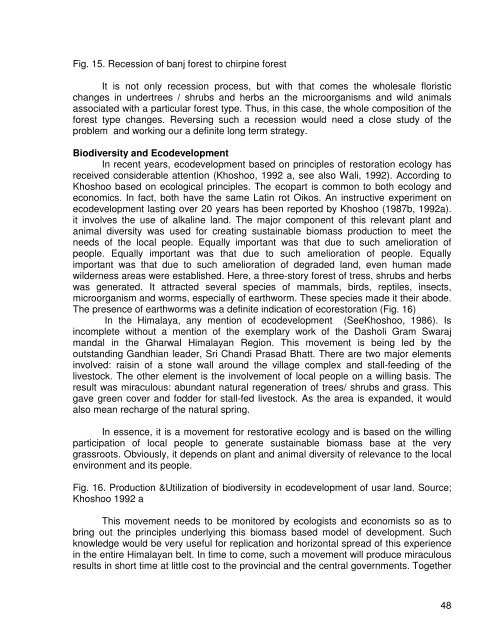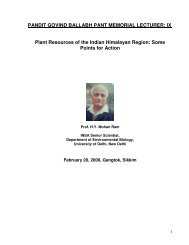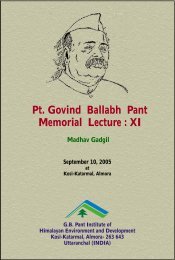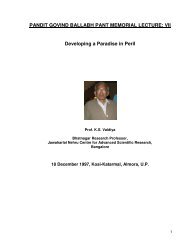Pandit Govind Ballabh Pant Memorial Lecture: II
Pandit Govind Ballabh Pant Memorial Lecture: II
Pandit Govind Ballabh Pant Memorial Lecture: II
Create successful ePaper yourself
Turn your PDF publications into a flip-book with our unique Google optimized e-Paper software.
Fig. 15. Recession of banj forest to chirpine forest<br />
It is not only recession process, but with that comes the wholesale floristic<br />
changes in undertrees / shrubs and herbs an the microorganisms and wild animals<br />
associated with a particular forest type. Thus, in this case, the whole composition of the<br />
forest type changes. Reversing such a recession would need a close study of the<br />
problem and working our a definite long term strategy.<br />
Biodiversity and Ecodevelopment<br />
In recent years, ecodevelopment based on principles of restoration ecology has<br />
received considerable attention (Khoshoo, 1992 a, see also Wali, 1992). According to<br />
Khoshoo based on ecological principles. The ecopart is common to both ecology and<br />
economics. In fact, both have the same Latin rot Oikos. An instructive experiment on<br />
ecodevelopment lasting over 20 years has been reported by Khoshoo (1987b, 1992a).<br />
it involves the use of alkaline land. The major component of this relevant plant and<br />
animal diversity was used for creating sustainable biomass production to meet the<br />
needs of the local people. Equally important was that due to such amelioration of<br />
people. Equally important was that due to such amelioration of people. Equally<br />
important was that due to such amelioration of degraded land, even human made<br />
wilderness areas were established. Here, a three-story forest of tress, shrubs and herbs<br />
was generated. It attracted several species of mammals, birds, reptiles, insects,<br />
microorganism and worms, especially of earthworm. These species made it their abode.<br />
The presence of earthworms was a definite indication of ecorestoration (Fig. 16)<br />
In the Himalaya, any mention of ecodevelopment (SeeKhoshoo, 1986). Is<br />
incomplete without a mention of the exemplary work of the Dasholi Gram Swaraj<br />
mandal in the Gharwal Himalayan Region. This movement is being led by the<br />
outstanding Gandhian leader, Sri Chandi Prasad Bhatt. There are two major elements<br />
involved: raisin of a stone wall around the village complex and stall-feeding of the<br />
livestock. The other element is the involvement of local people on a willing basis. The<br />
result was miraculous: abundant natural regeneration of trees/ shrubs and grass. This<br />
gave green cover and fodder for stall-fed livestock. As the area is expanded, it would<br />
also mean recharge of the natural spring.<br />
In essence, it is a movement for restorative ecology and is based on the willing<br />
participation of local people to generate sustainable biomass base at the very<br />
grassroots. Obviously, it depends on plant and animal diversity of relevance to the local<br />
environment and its people.<br />
Fig. 16. Production &Utilization of biodiversity in ecodevelopment of usar land. Source;<br />
Khoshoo 1992 a<br />
This movement needs to be monitored by ecologists and economists so as to<br />
bring out the principles underlying this biomass based model of development. Such<br />
knowledge would be very useful for replication and horizontal spread of this experience<br />
in the entire Himalayan belt. In time to come, such a movement will produce miraculous<br />
results in short time at little cost to the provincial and the central governments. Together<br />
48











